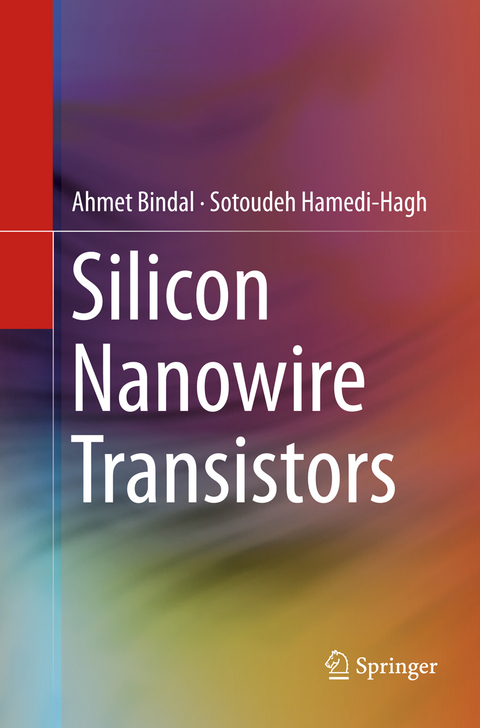
Silicon Nanowire Transistors
Springer International Publishing (Verlag)
978-3-319-80085-1 (ISBN)
Ahmet Bindal received his M.S. and Ph.D. degrees in Electrical Engineering Department from the University of California, Los Angeles CA. His doctoral research was the material characterization and analysis of HEMT GaAs transistors. During his graduate studies, he was a research associate and technical consultant for Hughes Aircraft Co. In 1988, he joined the technical staff of IBM Research and Development Center in Fishkill, NY, where he worked as a device design and characterization engineer. He developed asymmetrical MOS transistors and ultra thin Silicon-On-Insulator (SOI) technologies for IBM. In 1993, he transferred to IBM in Rochester, MN, as a senior circuit design engineer to work on the floating-point unit for AS-400 main frame processor. He continued his circuit design career at Intel Corporation in Santa Clara, CA, where he designed 16-bit packed multipliers and adders for the MMX unit for Pentium II processors. In 1996, he joined Philips Semiconductors in Sunnyvale, CA, where he was involved in the designs of instruction and data caches, and various SRAM modules for the Trimedia processor. His involvement with VLSI architecture also started in Philips Semiconductors and led to the design of the Video-Out unit for the same processor. In 1998, he joined Cadence Design Systems as a VLSI architect and directed a team of engineers to design self-timed asynchronous processors. After approximately 20 years of industry work, he joined the Computer Engineering faculty at San Jose State University in 2002. His current research interests range from nano-scale electron devices to nano-scale architectures and robotics. Dr. Bindal has over 30 refereed scientific publications and 10 invention disclosures with IBM. He currently holds three U.S. patents with IBM and one with Intel Corporation.Dr. Hamedi-Hagh received his Ph.D. from the University of Toronto, Canada in 2004. He joined the Electrical Engineering Department at San Jose State University (SJSU) in 2005. His areas of research and expertise include high frequency modeling of semiconductor device structures and design of Radio Frequency, Analog and Mixed-Signal integrated circuits for wireless and wireline communication systems. Dr. Hamedi-Hagh has developed the Radio Frequency Integrated Circuits laboratory and curriculum at both graduate and undergraduate levels with over $0.5M research funding and through close collaborations with industries. He has received several California State University (CSU) professional development grants, CSU Research Funds, Research, Scholarship and Creative Activity (RSCA) grants, SJSU Planning Council Grants, College of Engineering professional development grants and Junior Faculty Career Development Grants. He is a founding member of SJSU Smart Technology and Computing Center for Complex Systems (STCCS). In 2016, he was appointed as the Mixed-Signal endowed chair of the Electrical Engineering department. Dr. Hamedi-Hagh has over 30 refereed scientific journal and conference paper publications in prestigious national and international Institutes and societies. He received the best paper award at the Micronet Symposium in Quebec, Canada in 2001 and the IEEE International Symposium on Personal, Indoor and Mobile Radio Communications in Barcelona, Spain in 2004. Dr. Hamedi-Hagh has advised several hundred projects on design of integrated circuits and systems. He holds seven US and world patents on wireless circuits, systems and cryptography. His latest patent introduces suspendance® and trajectance® laws as alternatives to Kirchhoff’s laws for circuit analysis.
Dual Work Function Silicon Nanowire MOS Transistors.- Single Work Function Silicon Nanowire MOS Transistors.- Spice Modeling For Analog and Digital Applications.- High-Speed Analog Applications.- Radio Frequency (RF) Applications.- SRAM Mega Cell Design for Digital Applications.- Field-Programmable-Gate-Array (FPGA).- Integrate-And-Fire Spiking (IFS) Neuron.- Direct Sequence Spread Spectrum (DSSS) Base-Band Transmitter.-
| Erscheinungsdatum | 23.06.2018 |
|---|---|
| Zusatzinfo | XIV, 165 p. 145 illus., 5 illus. in color. |
| Verlagsort | Cham |
| Sprache | englisch |
| Maße | 155 x 235 mm |
| Gewicht | 284 g |
| Themenwelt | Technik ► Elektrotechnik / Energietechnik |
| Schlagworte | Carbon Nanotubes • Hybrid Memory Design • NMOS Transistors • Silicon Nanowire • Silicon Nanowire Transistors • System-on-Chip Design and Packaging • Ultra large scale Integration |
| ISBN-10 | 3-319-80085-X / 331980085X |
| ISBN-13 | 978-3-319-80085-1 / 9783319800851 |
| Zustand | Neuware |
| Haben Sie eine Frage zum Produkt? |
aus dem Bereich


